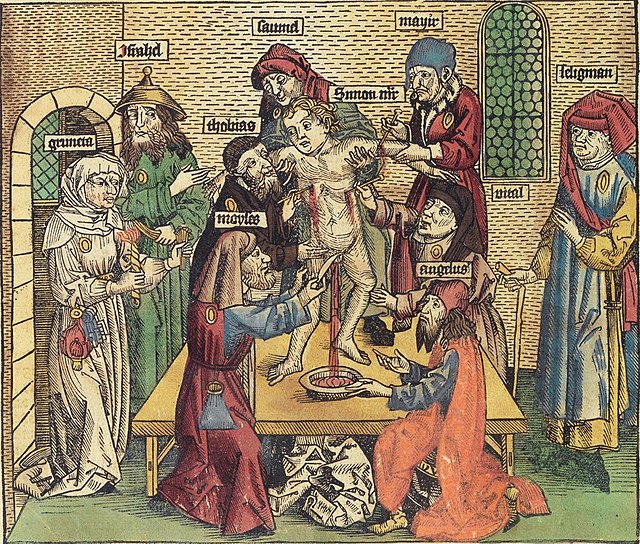History of the Jews in Italy
The history of the Jews in Italy spans more than two thousand years to the present. The Jewish presence in Italy dates to the pre-Christian Roman period and has continued, despite periods of extreme persecution and expulsions, until the present. As of 2019, the estimated core Jewish population in Italy numbers around 45,000.
The Great Synagogue of Rome
The treasures of Jerusalem (detail from the Arch of Titus).
Machzor written on parchment in Hebrew in an Italian square script and dated to the 14th or 15th century. Chester Beatty Library
Simon of Trent blood libel. Illustration in Hartmann Schedel's Weltchronik, 1493
The Roman Ghetto or Ghetto of Rome was a Jewish ghetto established in 1555 in the Rione Sant'Angelo, in Rome, Italy, in the area surrounded by present-day Via del Portico d'Ottavia, Lungotevere dei Cenci, Via del Progresso and Via di Santa Maria del Pianto, close to the River Tiber and the Theatre of Marcellus. With the exception of brief periods under Napoleon from 1808 to 1815 and under the Roman Republics of 1798–99 and 1849, the ghetto of Rome was controlled by the papacy until the capture of Rome in 1870.
Via Rua in Ghetto, (rione Sant'Angelo), by Ettore Roesler Franz (c. 1880)
Piazza Giudia, showing the gate of the ghetto (middle right), the police post and the gallows; engraving from: Giuseppe Vasi, Delle Magnificenze di Roma antica e moderna: Tome II, Le Piazze principali di Roma, con obelischi, colonne ed altri ornamenti. Roma: Stamperia degli eredi Barbiellini, 1752
Disappeared Ghetto: Arco delle Azimelle in a watercolour by Ettore Roesler Franz (1880 ca.). The Azimelle are Jewish unleavened breads, which were produced in a bakery in this lane.
Detail from the Arch of Titus showing spoils from the Sack of Jerusalem







